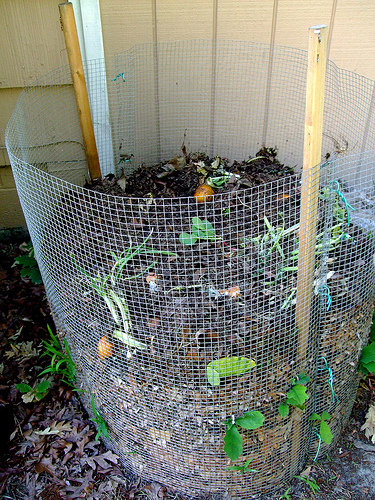What you do usually do with the dead leaves and food waste? Composting is also a good answer to recycle leaves and other yard waste. Instead of burning or hauling away leaves, you can compost them and return the nutrients to your garden to save money with your own compost!
What is compost?
To gardeners, compost is considered "black gold" because of its many benefits in the garden. Adding compost to clay soils makes them easier to work and plant. In sandy soils, the addition of compost improves the water holding capacity of the soil. By adding organic matter to the soil, compost can help improve plant growth and health.
The composting process
The composting process involves four main components: organic matter, moisture, oxygen, and bacteria.
Organic matter includes plant materials and some animal manures. All composting require three basic ingredients:
- Browns organic materials such as dead leaves, branches , twigs. The brown materials provide carbon for your compost
- Greens organic materials such as grass clippings, vegetable waste, fruit scraps, and coffee grounds. The green materials provide nitrogen.
- Water provides moisture to help breakdown the organic matter
The best ratio is 1 part green to 1 part brown material. Shredding, chopping or mowing these materials
- Select a dry, shady spot near a water source for your compost pile or bin.
- Add your brown and green materials as you collect them, making sure larger pieces are chopped or shredded. Smaller pieces will help speed the composting process by increasing the surface area.
- Moisten dry materials as they are added.
- Once your compost pile is established, mix green material into the pile and bury fruit and vegetable waste under 10 inches of compost material.
- Optional: Cover top of compost with a tarp to keep it moist.
- When the material at the bottom is dark and rich in color, your compost is ready to use (this is usually occurs in two months to two years).
Tip:
- If the pile is too dry, materials will decompose very slowly. Add water during dry periods or when adding large amounts of brown organic material.
- If the pile is too wet, turn the pile and mix the materials. Another option is to add dry, brown organic materials.
- Turning the pile is important for complete composting and for controlling odor.
- Wait at least two weeks before turning the pile, to allow the center of the pile to "heat up" and decompose. Once the pile has cooled in the center, decomposition of the materials has taken place. Frequent turning will help speed the composting process.
 |
| my compost bag |
- You may also add layers of soil or finished compost to supply more bacteria and speed the composting process. Commercial starters are available but should not be necessary for compost.
(I live in the city and have limited garden space. Therefore, I make my own compost in the soil/cement large bag (which water can go through) and shake it every 2 weeks. About 2-3 months, the compost will be ready J. You can adapt another bag or sack to make the compost.)
How long does it take?
The amount of time needed to produce compost depends on several factors, including the size of the compost pile, the types of materials, the surface area of the materials, and the number of times the pile is turned.
The number of times the pile is turned influences composting speed. By turning more frequently (about every 2-4 weeks), you will produce compost more quickly. Waiting at least two weeks allows the center of the pile to heat up and promotes maximum bacterial activity. The average composter turns the pile every 4-5 weeks.
With frequent turning, compost can be ready in about 3 months, depending on the time of year.
In winter, the activity of the bacteria slows, and it is recommended that you stop turning the pile after November to keep heat from escaping the pileís center. In summer, warm temperatures encourage bacterial activity and the composting process is quicker
Tips:
- If the pile has more brown organic materials, it may take longer to compost. You can speed up the process by adding more green materials or a fertilizer with nitrogen (use one cup per 25 square feet).
- ·When turning the compost pile, make sure that materials in the center are brought to the outsides, and that materials from the outside edges are brought to the center.
Using compost in the yard
Incorporate compost into your garden as you prepare the soil in the spring. Cover the area with 3-4 inches of soil and till it in to at least the upper 6 inches of soil.
Or you also use compost as mulch around flower beds, vegetable gardens, or around trees or shrubs in landscape beds. Apply a 3 inch layer. Be careful not to apply mulch close to the main stem or trunk of the plant.
Source: http://urbanext.illinois.edu, http://www.epa.gov/


